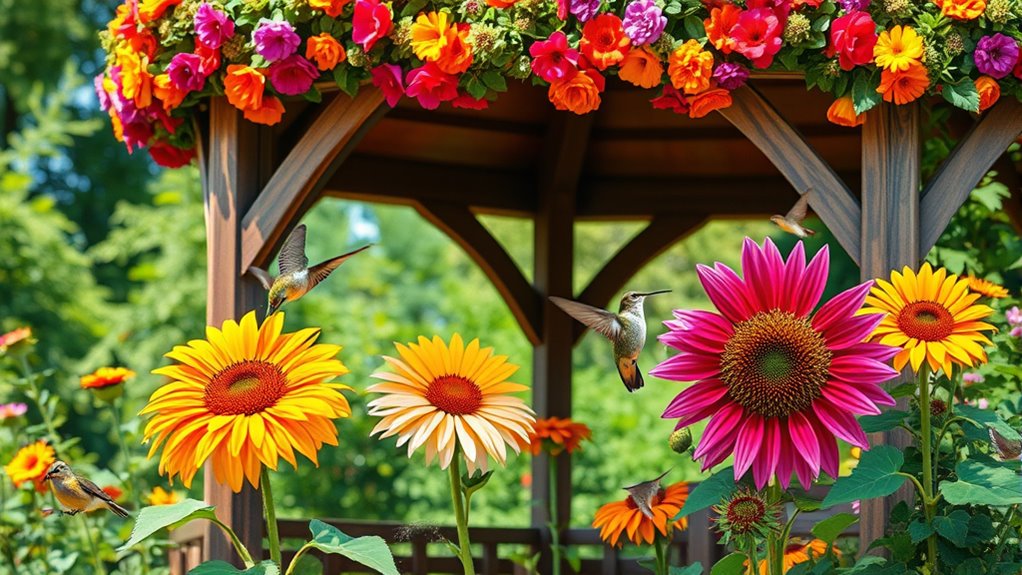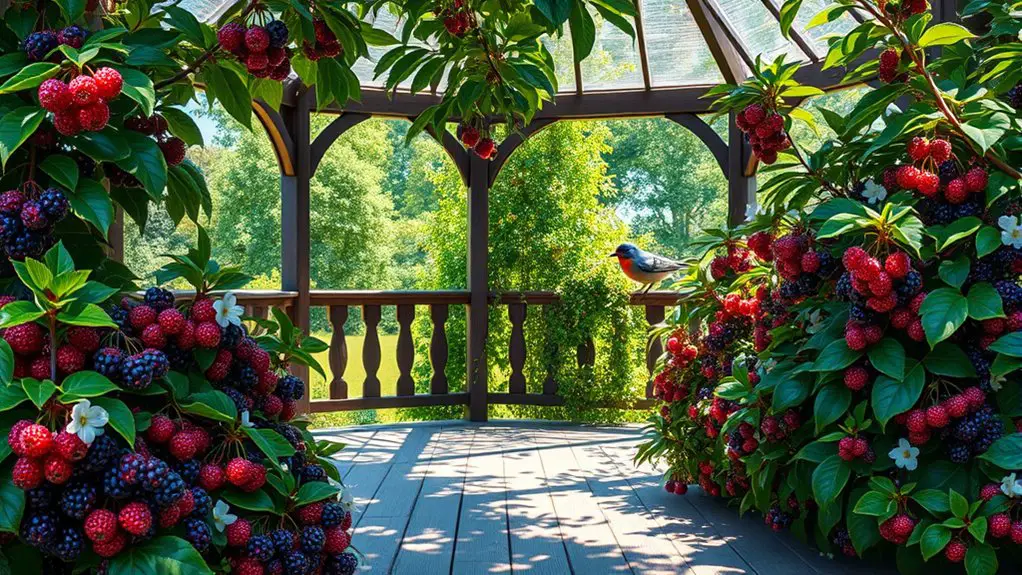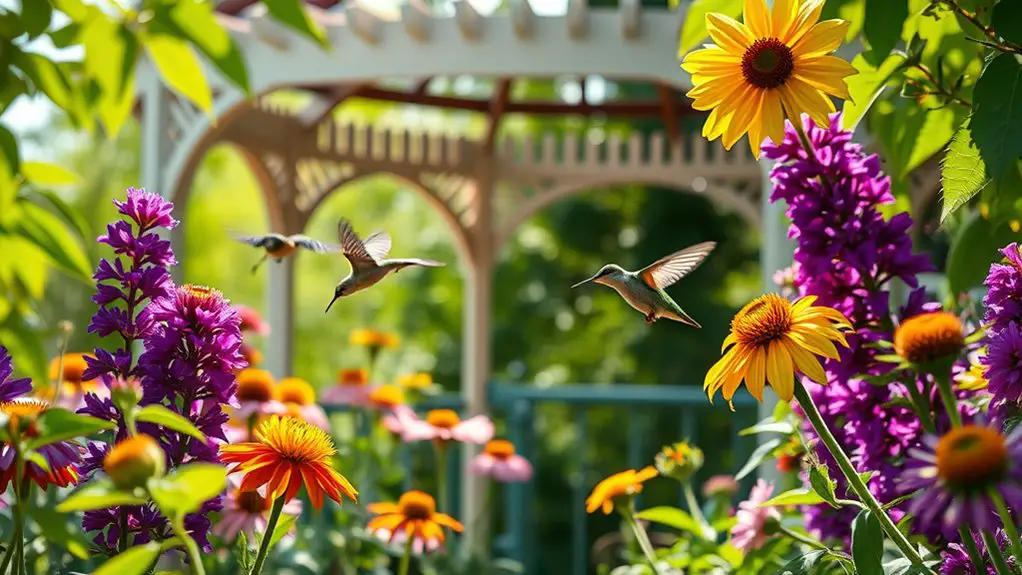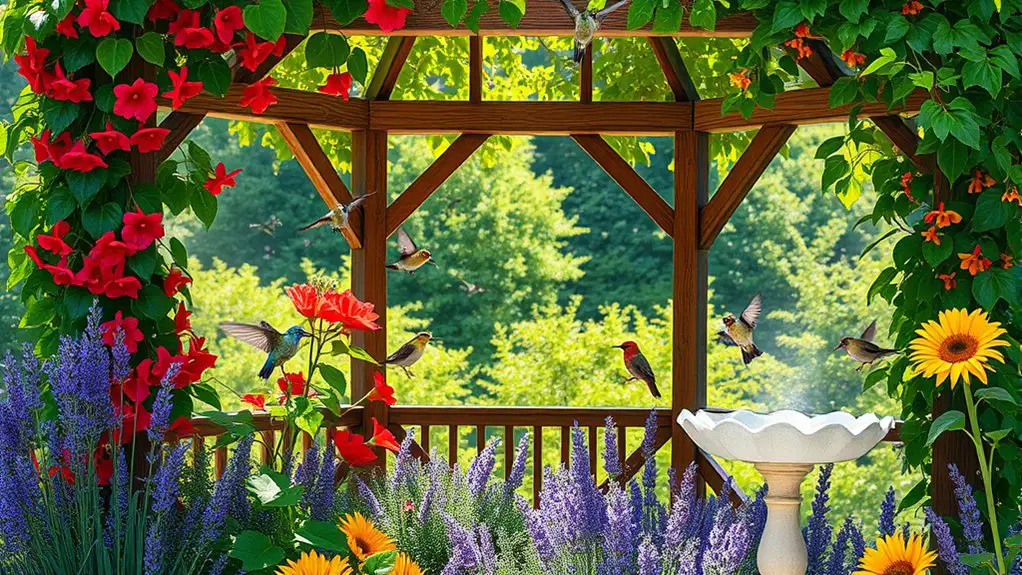To attract birds to your gazebo, choose native plants tailored to your region. Incorporate berry-producing shrubs like elderberry and serviceberry, and add nectar-rich flowers such as bee balm and hibiscus. Create shelter with evergreens like pines and junipers to provide year-round protection. Design open spaces for safe foraging and guarantee a nearby water source, like a birdbath, to entice feathered visitors. Discover how these elements can transform your gazebo into a vibrant bird haven.
Understanding Bird Preferences

Understanding the preferences of birds is essential if you want to attract them to your gazebo. To create a vibrant oasis, you need to take into account their habitat preferences, which vary greatly among species. Some birds thrive in dense shrubs, while others prefer open spaces. By offering a mix of perches, shelter, and nesting sites, you can cater to diverse avian visitors.
When it comes to bird food, think beyond simple seeds. Different birds have unique diets; some enjoy suet, while others favor nectar-rich flowers or fruits. Place feeders filled with a variety of offerings to entice them. Remember, the scent of fresh food can be incredibly inviting, drawing them closer to your gazebo.
Lastly, think about water sources. A shallow birdbath not only hydrates but also serves as a revitalizing splash zone where birds can play. By catering to their needs, you’ll create a welcoming sanctuary that celebrates their freedom.
Selecting Native Plants for Your Region
When you choose native plants for your region, not only do you enhance the beauty of your gazebo, but you also create a sustainable environment that supports local wildlife. By selecting plants that are naturally adapted to your regional climate, you promote local plant diversity and foster a thriving ecosystem.
Here are three key considerations when selecting native plants:
- Climate Compatibility: Choose plants that thrive in your area’s temperature and moisture levels. This guarantees they’ll flourish without excessive care.
- Local Ecological Benefits: Opt for species that attract and support local pollinators and birds, enhancing your gazebo’s natural charm.
- Soil Type: Understand your soil composition and select plants that can thrive within those conditions, reducing the need for amendments. Additionally, selecting climbing plants can provide both beauty and habitat for birds.
Embracing native flora not only beautifies your space but also nurtures the intricate balance of nature surrounding your gazebo.
Incorporating Berry-Producing Shrubs

To create a bird-friendly oasis around your gazebo, incorporating berry-producing shrubs is crucial. These vibrant plants not only offer delicious treats for feathered visitors but also enhance your landscape with their colorful fruits. By choosing the right varieties and paying attention to their planting locations and seasonal care, you’ll guarantee a thriving habitat that attracts a variety of birds year-round.
Best Berry Shrubs
Creating a vibrant and inviting atmosphere in your gazebo can be as simple as incorporating berry-producing shrubs. These plants not only enhance your space but also attract birds with their delicious fruits. Here are three bird-friendly varieties you should consider for ideal berry production:
- Elderberry: This shrub offers clusters of dark berries that are a favorite among birds and can also be used for delicious jams.
- Serviceberry: With its early-season berries, this shrub provides an essential food source for migrating birds.
- Blueberry: Not only do these shrubs produce sweet berries for you, but they also attract numerous bird species enthusiastic for a tasty treat.
Choose these shrubs to create a lively, bird-friendly haven right in your gazebo!
Planting Location Tips
While selecting the right spot for your berry-producing shrubs, consider both sunlight and accessibility to make the most of your gazebo’s natural beauty. Ideal sunlight exposure is essential; most berry shrubs thrive in at least six hours of direct sunlight daily. Guarantee the soil type is well-draining and rich in organic matter to support healthy growth.
Here’s a quick reference table to guide you:
| Sunlight Exposure | Soil Type |
|---|---|
| Full Sun (6+ hrs) | Sandy Loam |
| Partial Shade (3-6 hrs) | Loamy Soil |
| Full Shade (less than 3 hrs) | Clay Soil |
| Morning Sun | Well-drained Soil |
| Afternoon Sun | Nutrient-rich Soil |
Seasonal Care Requirements
As the seasons change, your berry-producing shrubs require specific care to flourish and enhance the beauty of your gazebo. To keep them thriving and inviting to birds, follow these essential seasonal care tips:
- Seasonal Pruning: Trim back old growth in late winter to encourage new, vibrant shoots that produce abundant berries in spring.
- Fertilization: Apply a balanced, organic fertilizer in early spring to provide essential nutrients, promoting healthy growth and berry production.
- Winter Protection: Mulch around the base to insulate roots and cover with burlap if you live in an area with harsh winters, shielding them from frost damage.
Adding Nectar-Rich Flowers

To create a vibrant haven for birds, consider incorporating nectar-rich flowers that not only beautify your gazebo but also attract a variety of winged visitors. Choose the best plants, like bee balm and salvia, and remember to plant them in clusters for maximum impact. Seasonal considerations are key; timing your planting can guarantee a continuous bloom that keeps your feathered friends coming back.
Best Nectar Plants
Nectar-rich flowers are the secret ingredient to transforming your gazebo into a vibrant haven for birds. By selecting the right plants, you’ll create abundant nectar sources, enhancing pollinator attraction and delighting feathered visitors. Here are three of the best nectar plants to contemplate:
- Bee Balm – This aromatic plant not only attracts hummingbirds but also bees and butterflies, creating a lively ecosystem.
- Salvia – With its vivid spikes of flowers, salvia provides a continuous nectar supply, perfect for energetic pollinators.
- Hibiscus – Its large, showy blooms are irresistible to birds and add a tropical flair to your space.
Incorporate these beauties into your gazebo garden, and watch as your space comes alive with avian activity!
Planting Tips
When planning your gazebo garden, consider the ideal conditions for planting nectar-rich flowers to guarantee they thrive and attract birds. Start with proper soil preparation; enrich it with organic matter to confirm excellent drainage and nutrients. Test the pH, aiming for a slightly acidic to neutral range, which many flowering plants prefer. Don’t forget to integrate companion planting; pairing flowers like coneflowers with bee balm can enhance biodiversity and draw even more pollinators. Choose a sunny spot, as most nectar-rich plants flourish in bright light. Water regularly but avoid waterlogging. With these planting tips, you’ll create an inviting sanctuary where birds flock to sip nectar, bringing life and joy to your gazebo oasis.
Seasonal Considerations
As your gazebo garden flourishes with vibrant blooms, considering the seasonal changes will help you maintain a consistent supply of nectar throughout the year. To attract birds, focus on these key seasonal plants:
- Spring Blooms: Choose early flowering plants like columbine and bee balm that provide essential nectar as birds return from migration.
- Summer Favorites: Incorporate sunflowers and coneflowers, which not only offer abundant nectar but also seeds for winter birds.
- Winter Foliage: Select evergreen shrubs like holly or winterberry, ensuring your garden remains a refuge and food source even in colder months.
Creating Shelter With Evergreens
Creating a welcoming environment for birds around your gazebo can be greatly enhanced by incorporating evergreens, since these hardy plants provide essential shelter year-round. When you choose the right evergreen varieties, like pines, spruces, and junipers, you’re not just adding greenery; you’re creating living quarters for your feathered friends. The dense foliage acts as a protective barrier against harsh weather, offering refuge from storms and predators alike.
Birds love the shelter benefits of evergreens, as they provide nesting sites and a safe haven for feeding. Imagine watching colorful songbirds flit among the branches, secure and content in their natural haven. By incorporating a mix of heights and textures, you can create a lush, layered landscape that invites various species. With these resilient plants surrounding your gazebo, you’ll not only attract birds but also experience a vibrant ecosystem brimming with life and activity.
Designing a Bird-Friendly Landscape
To cultivate a bird-friendly landscape around your gazebo, consider the interplay of plants, water sources, and feeding stations that harmonize with the natural behaviors of local bird species. A thoughtful design will not only attract birds but also enhance your landscape aesthetics. Here are three key elements to include:
- Native Plants: Choose a variety of native plants that provide food and shelter for different bird species. Think berries, seeds, and nectar-producing flowers.
- Layering: Create layers in your plant selection. Taller trees can provide perches, while lower shrubs offer cover for nesting and feeding.
- Open Spaces: Include clearings or open areas. These spaces allow birds to forage safely and showcase your gazebo as a central gathering point.
Providing Water Sources
A well-designed landscape around your gazebo becomes even more inviting for birds when water sources are thoughtfully integrated. Adding birdbaths is essential, but their placement matters just as much as their design. Locate them in sunny spots near shrubs for safety and accessibility.
Consider incorporating a simple water filtration system to keep the water clean and appealing. Here’s a quick reference table to help you choose the right birdbath:
| Birdbath Type | Benefits |
|---|---|
| Classic Ceramic | Attractive & durable |
| Fountain Style | Moving water attracts birds |
| Heated Birdbath | Year-round access |
| Solar-Powered | Eco-friendly & self-cleaning |
| Hanging Birdbath | Saves space & unique appeal |
Maintenance Tips for Your Bird Habitat
Maintaining your bird habitat is essential for attracting a variety of feathered friends throughout the year. With a little effort, you can guarantee a thriving ecosystem that promotes habitat sustainability and effective bird feeding. Here are some key maintenance tips:
- Regularly Clean Feeders: To prevent disease, clean bird feeders weekly with a mild bleach solution. Rinse thoroughly and allow to dry before refilling.
- Prune and Maintain Plants: Keep your native plants healthy by pruning dead branches and removing invasive species. This encourages growth and provides shelter for birds.
- Monitor Water Sources: Confirm any water features are clean and free of debris. Change the water regularly to keep it fresh for your feathered visitors.
Frequently Asked Questions
What Time of Year Is Best for Planting Bird-Friendly Plants?
Spring planting’s like opening a door to nature’s symphony. As the frost melts, consider seasonal considerations; that’s when birds seek fresh food sources, making it the perfect time to introduce bird-friendly plants to your garden.
How Do I Choose the Right Location for My Gazebo Planting?
To choose the right location for your gazebo planting, consider sunlight exposure and soil quality. Look for areas that get adequate sunlight and have rich, well-draining soil to create a vibrant, inviting space for nature’s visitors.
Are There Specific Plants to Avoid Around My Gazebo?
You’ll want to steer clear of invasive species and toxic plants around your gazebo. They can disrupt local ecosystems and pose health risks, limiting your freedom to enjoy a vibrant, safe outdoor space filled with life.
Can I Attract Specific Bird Species With Certain Plants?
Yes, you can attract specific bird species by choosing native plants that align with their feeding preferences. These plants provide essential food sources and habitats, enhancing your outdoor space’s biodiversity and inviting vibrant avian visitors.
How Long Does It Take for Plants to Attract Birds?
It usually takes several weeks to months for plant growth to attract birds, as their behavior shifts with seasonal changes. Patience is key; enjoy watching nature unfold and discover which plants resonate with your feathered friends.

